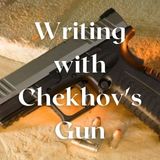Creative Writing Tips for Novelists and Dramatica Users
By Glen C. Strathy
Most creative writing tips you'll find on the web, in books, or in courses are based on the collective experience of many writers, with a little narrative theory drawn from academia thrown in.
Naturally, some sources are better than others, and not all of this wisdom has been put into a coherent system. In fact, many reject the idea of having a coherent system or method of creative writing, favouring the idea of the writer who continually reinvents his craft from scratch. Consequently, most writers learn how to write primarily through trial and error and osmosis - by writing a lot and reading other people's books. In addition, writers who give workshops feel a certain pressure to create original writing methods, approaches, and tips (even if they are merely old tips with new names).
A lot of confusion therefore results from writers continually having to "reinvent the wheel" when it comes to creative writing. Nonetheless, a beginning writer will find a lot of valuable information readily available – which is fantastic.
Dramatica Theory is the most comprehensive story theory created to date, but it also adds a little to the confusion because it uses many terms that are quite different from those used in most creative writing courses. And writing teachers use terms not found in Dramatica. This is a barrier that is worth tearing down.
In the articles below, we discuss some of common and useful creative writing tips you'll find taught in writing courses and how they look through the lense of Dramatica. We hope this will end a little of the confusion and make it easier for you to focus on your writing.
We'll also look at some other ways you can improve your creativity in general, and apply them to writing specifically.
Some Useful Creative Writing Tips
How to Write the 9 Types of Action Scenes
Chases, races, escapes, shootouts, etc. are common in many fiction genres. Here are some tips on how to write the various types of action scenes your story may require
How to Write a Fight Scene
A look at how to structure formal and informal fight scenes to make them more interesting and emotionally engaging.
6 Ways to Boost Your Creativity so You Can Write Better Stories
Ever wish you could increase your creativity? Here are six simple techniques you can use to put yourself in the optimum state of mind for creative writing. Use them to get more enjoyment and satisfaction from the writing process.
How to Begin a Novel: Beginnings that will Hook Your Reader
Not every story begins at the beginning. Here are some tips on choosing what point to begin your story, how to write effective beginnings, and how to avoid cliched beginnings.
How to End a Novel -- And How Not To
Here we look at what makes an effective story ending versus one that is unsatisfying. We also look at the different types of endings in both categories.
Using Chekhov's Gun to Tie Your Story Together
First articulated by the great playwright Anton Chekhov, this plot device involving objects or sometimes characters can help tie together the plot of your novel.
Beginning In Medias Res
This literary technique dates back to the ancient Greek writer, Homer. Starting your novel in medias res will hook your readers attention, but what if you feel you should establish your main character first? Here are some options.
Internal vs. External Conflict
Emotional depth in a story comes from developing the main character's internal conflict as well as the external conflict. Here's how to tell these two apart and how to use them.
Preventing "Sagging Middle Syndrome"
It is a common saying among writers that every story goes wrong after act one. We call this phenomenon "sagging middle syndrome." Here's how to prevent your novel from falling victim to it.
Ticking Clock or Option Exhaustion: How to Bring Your Plot to a Crisis
There are two main ways you can bring your story to its crisis (the point of maximum tension), before you reveal the resolution. Sometimes you can use both...
- Home
- Storytelling Tips






































